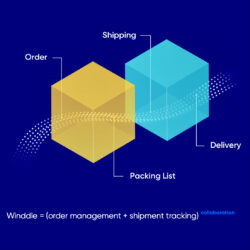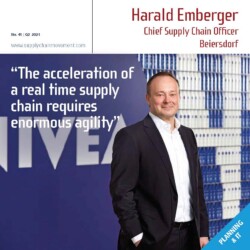More visibility will strengthen supply chain resilience in fashion industry

Fashion companies with long, complex supply chains are struggling because they lack the ability to respond quickly and adequately to unexpected events. During a recent Webinar Wednesday, start-up Winddle and consultancy KPMG explained how companies in the fashion industry can make their supply chains more resilient. The first step is to bridge the gap between the ERP and WMS.
By Marcel te Lindert
In the middle of the webinar, one listener pointed out that fashion company GAP recently incurred a US$162 million loss. It was caused by the Old Navy clothing brand, whose net sales fell by 19% because of availability problems. The clothing brand had sufficient stock, but in the wrong sizes; the large sizes remained unsold, while disruptions in the supply chain meant that the medium sizes could not be replenished fast enough.
New crisis situations
GAP’s experience underscores the message of Winddle and KPMG during the webinar, both of whom stressed the importance of more supply chain resilience. “I’m not telling you anything new when I say that the events of the past few years have caused a lot of turmoil in our supply chains,” said Safa Chhab, Operations & Supply Chain Manager at KPMG. “In France alone, 86% of companies have production or supply chain issues. Delays in our global supply chains have increased by as much as 30% in the past six months.”
And there is no end in sight, as illustrated by the war in Ukraine and the Shanghai lockdown. “We go from one crisis to another, from COVID-19 to the climate crisis. The situation is unstable and we have to expect new crises to arise. How can we arm our supply chains against that? By strengthening resilience,” Chhab claimed.
Long lead times
In view of its complexity, the fashion industry could definitely use some extra resilience. In extreme cases, the supply chains have up to 350 suppliers and 50 different production sites, and close cooperation is essential to get the right clothes to the right consumer at the right time. “Not to mention the geographical spread. In many cases, the supplier is located on a different continent, mainly in Asia. That makes collaboration difficult and causes long lead times,” Chhab added.
Emilia Jevakhoff highlighted the lack of supply chain digitalization in the fashion industry. Most fashion companies have an ERP system that generates purchase orders and a warehouse management system (WMS) that registers incoming goods in the warehouse months later, but what happens in between is often a blind spot. “In the vast majority of cases, there is no daily exchange of data with suppliers, factories, transporters and other supply chain partners. Even within companies, there are many departments that need to know which goods will be arriving when,” explained the CEO of Winddle, winner of the European Supply Chain Start-up Contest in 2021.
Excel
Winddle is a platform that bridges the gap between the ERP and WMS to create visibility into the supply chain. This supports better collaboration between all the relevant partners and improves productivity. The platform originated in the fashion industry and now has more than 3,500 daily users, including in other sectors. “We see that many companies are still using Excel to manage their processes. That makes it difficult to respond quickly and adequately to unexpected events in the supply chain. For example, purchase orders are rarely delivered in the right quantities at the right time and at the right cost. Of course, we can implement super-smart algorithms for supply chain planning. But if you’re not able to react quickly to operational problems, their value is limited.”
Chhab agreed: “To be truly agile, you need to be willing to constantly double-check your planning by testing it against scenarios. This is only possible if you can rely on data that is as up-to-date, correct and complete as possible. That’s why it’s not enough to work with Excel and email. Moreover, when systems and processes fail, it is often the people in the supply chain who compensate by working even harder. That’s not healthy for your team in the long run either.”
Forced to look further ahead
A resilient supply chain is built on four pillars, according to both of the experts. The first pillar is about getting a grip on internal processes and data. Many supply chains lack structured processes and accessible, high-quality data. Chhab: “Take planning and scheduling: these are the processes that are perhaps most affected by the current crisis situations because they require a lot of interaction with supply chain partners, so it is even more important to ensure structured processes and data. Or think about integrated business planning (IBP); it brings together all the relevant disciplines to make joint decisions, but only if the data is in order.”
The second pillar relates to operational visibility and the ability to anticipate. The current supply chain disruptions are forcing companies to look further ahead. “End-to-end visibility helps you to anticipate. I currently have some clients who now have to commit with their suppliers six months in advance in order to obtain their products. They need the right information to know how many products they want to order from their supplier. Meanwhile, fashion companies like Lacoste are telling us that they now have to confirm container bookings a month in advance; that used to be 15 days.”
Nurturing relationships
The third pillar concerns the relationships with the supply chain partners, which must be nurtured in order to secure deliveries. Chhab: “Be aware of the impact of your actions on your suppliers. Analyse who your most important suppliers are and build a platform that enables you to share data with them on a daily basis. Which orders have you placed? When will they be delivered? Which order has the highest priority? Remember, the more information you share with your partners, the more information they will share with you.”
The fourth pillar revolves around the ability to model scenarios so that your company can make faster and better decisions in times of crisis. Jevakhoff: “This is also about the ability to seize opportunities. It’s about the ability to partner up with a new supplier or carrier at lightning speed. For maximum responsiveness, you need standardized and harmonized processes and a platform that enables you to set up a new partnership quickly. Don’t wait for a solution that will eliminate all your problems at once; get started today by taking the first step towards building a resilient supply chain.”
Watch the recording of this webinar on YouTube!










